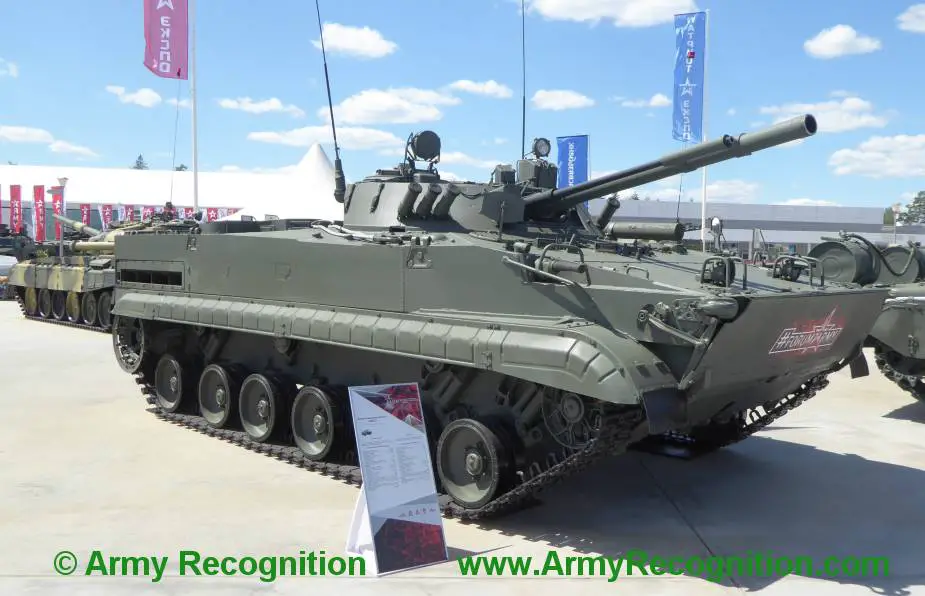Russia’s exports of land hardware have exceeded 7,000 systems since 2000, a spokesperson for the Rosoboronexport arms exporting company (a subsidiary of Rostec) told the TASS news agency on November 18 : “Rosoboronexport has exported more than 7,000 land armored platforms worth approximately USD30 billion to 44 countries,” he said.
Follow Army Recognition on Google News at this link

BMP-3 (Picture source: Army Recognition)
Since the early 2000s, Russia’s defense industry has dramatically reinforced its land portfolio. Previously, it was built of mostly Soviet-designed weapon systems, for instance, the T-72-family MBTs, BMP-1 and BMP-2 infantry fighting vehicles (IFVs), BTR-70 and BTR-80 armored personnel carriers (APCs), and BRDM-2 4×4 reconnaissance vehicles. It should be mentioned that now the portfolio includes more sophisticated land systems.
Russia’s cluster of export-oriented MBTs is built of the baseline T-90S and the upgraded T-90MS tanks. The T-14 Armata new-generation MBT is on its way to the global market; however, it has yet to receive a license permitting the platform’s export to foreign countries. Therefore, it is the T-90MS MBT that holds the title of the most sophisticated ready-to-use heavy vehicle developed by the Russian industry. The T-90MS is a net-centric land system that features an advanced fire-control unit with a thermal imager and a number of sophisticated sensors. Its smoothbore gun allows the tank’s crew to fire a wide range of 125 mm munitions and anti-tank guided missiles.
The Russian defense industry is intensively updating its assets that date back to the early 1990s. For example, the BMP-3 IFV is still a subject to various upgrades, including dramatic ones. New models sometimes see daylight: at the Army 2020 international military-technical forum held in Kubinka near Moscow, Rostec’s holding High-Precision Weapons showcased the Manul IFV with updated protection, a remotely operated weapon station, and a frontally mounted powerpack. In late April, the Bumerang 8×8 wheeled armored fighting vehicle was unveiled in its export-oriented configuration.
The well-proven Russian-designed land systems are also in demand on the market: the BTR-82A APC still has its renown.
Since 2000, Rosoboronexport has entered the lucrative realm of 4×4 protected utility vehicles. In the early 2000s, the BRDM-2 scout car was the only system of the type in the Russian defense industry’s land portfolio. Some 15 years ago, the company brought the Tigr 4×4 utility vehicle to the market, and now the platform holds its place among the world’s most popular 4×4 military-grade automotive vehicles. The Tigr now serves as a chassis for some 20-30 export-oriented wheeled support systems.
The Russian defense industry has also paid specific attention to its artillery portfolio, which now includes the newest Tornado-G 122 mm multiple rocket launch (MRL) system, the Tornado-S 300mm MRL (MLRS), the TOS-1A Solntsepyok rocket launcher (heavy flamethrower), and the Msta-S family of 152mm and 155mm self-propelled howitzers.
Russia has entered the market of light tanks with the Sprut-SDM1 125mm self-propelled anti-tank gun (SPATG) being the latest platform of the type in its industrial portfolio. Unlike its market competitors (for instance, Turkey’s Kaplan and China’s Type 15), the Sprut-SDM1 is armed with an almost full-scale 125mm gun capable of firing the rounds and anti-tank missiles of the T-90S/MS MBTs.
It should be mentioned that Rosoboronexport has fully switched from the shipment of ready-use hardware only to delivery of multifaceted solutions. At present, all Russian export-oriented land platforms (including the T-72 and T-90 tanks, the BMP-3 IFVs, and the TOS-1A heavy rocket launchers) are complemented with sophisticated electronic/virtual reality training systems developed by JSC Trenazherniye Sistemy (Training Systems).
© Copyright 2020 TASS / Army Recognition Group SPRL. All rights reserved. This material may not be published, broadcast, rewritten or redistributed.














